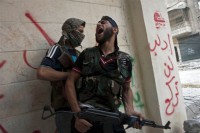
This post was written by Sean Langberg, our Education Coordinator, and Danny Hirschel-Burns, our Policy Coordinator. It is the first in our new blog series, #Syriasly, which presents a variety of perspectives on the Syrian conflict. This post provides an overview.
On March 11, 2012, at least 45 women and children were stabbed and burned to death in Homs, a city in western Syria. Hours prior, the United Nations special envoy to Syria, Kofi Annan, met with Bashar al-Assad in an effort to find a diplomatic solution to the conflict. At least fifteen other massacres have taken place since then in the Syrian crisis, including one on June 13th during which Syrian opposition fighters killed 60 Shi’ites in Hatla, including a mix of women and children. Civilian deaths only intensified as the conflict shifted from a series of peaceful protests to a brutal crackdown.
The conflict began in March 2011 as protests in Southwest Asia and North Africa came and went as part of the Arab Spring. It started as a series of demonstrations against the Bashar al-Assad regime that has been in power since 2000, but his father, Hafez al-Assad, also led an authoritarian regime that resorted to violence as a means of social and political control. Protests quickly spread across the country drawing a harsh and escalated police response. The conflict gradually diverged from other uprisings such as the ones in Tunisia and Egypt and took on qualities of a violent multi-sided conflict as it became clear Assad was not going to negotiate with protesters.
Now, the conflict involves a complex mix of international and multinational actors that are seeking to influence the outcome of the conflict. Iran, Hezbollah, and Russia have all, in one way or another, supported the Assad regime. Iran, which shares a Shi’ite religious tradition with Assad’s Alawites, has provided substantial financial assistance and Revolutionary Guard troops to Syria’s government. Hezbollah, a militant group based in Lebanon, has similarly contributed troops to Assad. Finally, Russia represents Syria’s most powerful ally on the international stage. Russia’s final Mediterranean port lies on the Syrian coast, and a long line of Russian foreign policy thinking sees protests and repression as internal matters that do not merit international involvement. Russia has provided the Assad regime with some weaponry, but more importantly, it, often along with China, has served as a spoiler to prevent UN action on Syria. Its position as a permanent member of the Security Council means it has the power to block any potent, UN-sanctioned resolutions on Syria.
The Syrian opposition also has a diverse mix of international allies. The United States and the European Union have been supportive of the opposition since early in the conflict, consistently engaging with both political and military resistance groups. The United States, beginning last year, has supplied humanitarian assistance to refugees and “non-lethal” aid to Syrian rebels. Then this past Thursday, the White House announced that it will begin to arm US-friendly opposition groups. Additionally, Qatar, Saudi Arabia, Libya, Turkey, Jordan, Iraq, and Lebanon have all, to varying degrees, assisted rebel forces. Qatar and Saudi Arabia have aggressively and openly supported the opposition, and thus far, are the biggest sources of lethal aid.
Check here for a visual representation of important actors
Check here for a map of important actors (zoom out for full map)
Throughout the course of the conflict, governments and international organizations have largely been unable to respond effectively to the multilayered crisis. Humanitarian aid has been slow to arrive, and when it has, it has often been too little. This chronic shortage caused the UN to put out its largest call for donations ever to aid Syrian displaced persons and refugees. Diplomatically, Syria has been a failure for the international community. UN observer missions attempted to use their presence as a buffer to prevent violence against civilians, but eventually the severity of the conflict made their position untenable. Lakhdar Brahimi, and Kofi Annan before him, has tried as the UN’s Special Envoy without success to bring the two opposing parties together on a negotiated solution to the conflict. While Russia has made action in the UN Security Council (UNSC) impossible, peace talks are planned, if not scheduled, in Geneva in the near future. Finally, some sort of military intervention has been on the table for over a year now, but the various proposals, from a no fly zone to airstrikes have not happened because of a combination of tactical concerns and a serious lack of international political will. Full scale military intervention has been proposed by a few, but without a UNSC-sanctioned mission, there is not a single power or an international coalition willing to intervene. The most recent move by the US, arming the Syrian Military Council, is in response to growing calls for US action, but most analysts do not believe these arms will do enough to significantly alter the trajectory of the conflict.
The death toll and refugee count are climbing and shows no sign of slowing down. The first casualties occurred on March 18, 2011, during the first days of civilian-led protests. Protests grew, spread, and eventually were subsumed in a violent conflict no longer led by civilians. As a result, the death toll spiraled upward reaching 60,000 in January 2013 and eventually ~93,000 in April 2013 according to the United Nations.

(Based on data from the Syrian National Council)
Additionally, a second crisis is taking place outside of the country as millions of Syrians flee the violence. Over 1.1 million refugees have spilled over into Jordan, Lebanon, Turkey, Iraq, Egypt, Algeria, and Armenia. Also, as of September 2012, the number of internally displaced persons was approximately 2 million.

(Based on data as of March 2013)
In the coming weeks, our bloggers will offer several different perspectives about the atrocities in Syria, ranging from U.S. foreign policy to Syrian American students.
